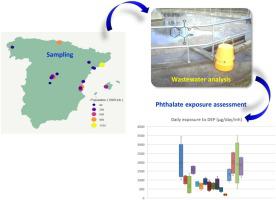Journal of Hazardous Materials ( IF 12.2 ) Pub Date : 2020-06-22 , DOI: 10.1016/j.jhazmat.2020.123272 Iria González-Mariño 1 , Leticia Ares 2 , Rosa Montes 2 , Rosario Rodil 2 , Rafael Cela 2 , Ester López-García 3 , Cristina Postigo 3 , Miren López de Alda 3 , Eva Pocurull 4 , Rosa María Marcé 4 , Lubertus Bijlsma 5 , Félix Hernández 5 , Yolanda Picó 6 , Vicente Andreu 6 , Andreu Rico 7 , Yolanda Valcárcel 8 , Manuel Miró 9 , Néstor Etxebarria 10 , José Benito Quintana 2

|
Phthalates are widely used plasticizers that produce endocrine-disrupting disorders. Quantifying exposure is crucial to perform risk assessments and to develop proper health measures. Herein, a wastewater-based epidemiology approach has been applied to estimate human exposure to six of the mostly used phthalates within the Spanish population. Wastewater samples were collected over four weekdays from seventeen wastewater treatment plants serving thirteen cities and ca. 6 million people (12.8 % of the Spanish population). Phthalate metabolite loads in wastewater were transformed into metabolite concentrations in urine and into daily exposure levels to the parent phthalates. Considering all the sampled sites, population-weighted overall means of the estimated concentrations in urine varied between 0.7 ng/mL and 520 ng/mL. Very high levels, compared to human biomonitoring data, were estimated for monomethyl phthalate, metabolite of dimethyl phthalate. This, together with literature data pointing to other sources of this metabolite in sewage led to its exclusion for exposure assessments. For the remaining metabolites, estimated concentrations were closer to those found in urine. Their 4-days average exposure levels ranged from 2 to 1347 μg/(day∙inh), exceeding in some sites the daily exposure thresholds set for di-i-butyl phthalate and di-n-buthyl phthalate by the European Food Safety Authority.
中文翻译:

通过对废水的分析,评估西班牙十三座城市中邻苯二甲酸盐类增塑剂的暴露量。
邻苯二甲酸酯是广泛使用的增塑剂,可产生破坏内分泌的疾病。量化暴露对于执行风险评估和制定适当的健康措施至关重要。在本文中,已经采用了一种基于废水的流行病学方法来估计人类接触西班牙人口中六种最常用的邻苯二甲酸盐的程度。在四个工作日内,从服务于13个城市和加利福尼亚州的17个废水处理厂收集了废水样本。600万人(占西班牙人口的12.8%)。废水中的邻苯二甲酸盐代谢物负荷转化为尿液中的代谢物浓度,并转化为母体邻苯二甲酸盐的每日暴露水平。考虑到所有采样点,尿液中估计浓度的人群加权总体平均值在0.7 ng / mL和520 ng / mL之间变化。很高的水平 与人类生物监测数据相比,对邻苯二甲酸二甲酯(邻苯二甲酸二甲酯的代谢产物)进行了估算。这与指出污水中该代谢物其他来源的文献数据一起,导致将其排除在暴露评估之外。对于剩余的代谢物,估计浓度接近尿液中的浓度。它们的4天平均暴露水平范围为2至1347μg/(day∙inh),在某些地方超过了每日平均暴露水平我丁基邻苯二甲酸二-N-丁<br/>欧洲食品安全局邻苯二甲酸酯。











































 京公网安备 11010802027423号
京公网安备 11010802027423号